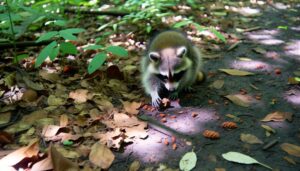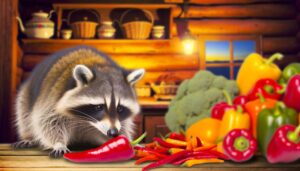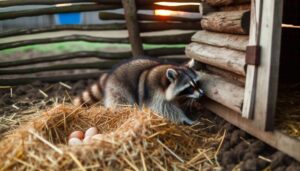How Do Raccoons Eat Grape Jelly Safely?
Raccoons are omnivores with diverse diets, including fruits, nuts, and occasionally sugary substances like grape jelly. Their foraging behavior adapts to available food sources, especially in urban settings where they exploit human food waste.
Observational studies confirm raccoons' affinity for high-sugar foods such as grape jelly. However, regular consumption of grape jelly can lead to health issues like obesity and dental problems in raccoons due to its high sugar content and lack of nutrients.
To reduce raccoon visits, secure trash bins and eliminate outdoor food sources. Understanding their dietary habits reveals more about managing raccoon interactions effectively.

Key Takeaways
- Raccoons exhibit a notable preference for high-sugar foods, including grape jelly.
- Observational studies confirm that raccoons actively seek out and consume grape jelly.
- Raccoons' opportunistic foraging behavior includes raiding households for accessible foods like grape jelly.
- Consuming grape jelly can cause health problems in raccoons, such as obesity and dental issues.
- Preventive measures like securing trash cans can help deter raccoons from accessing grape jelly.
Raccoons' Natural Diet
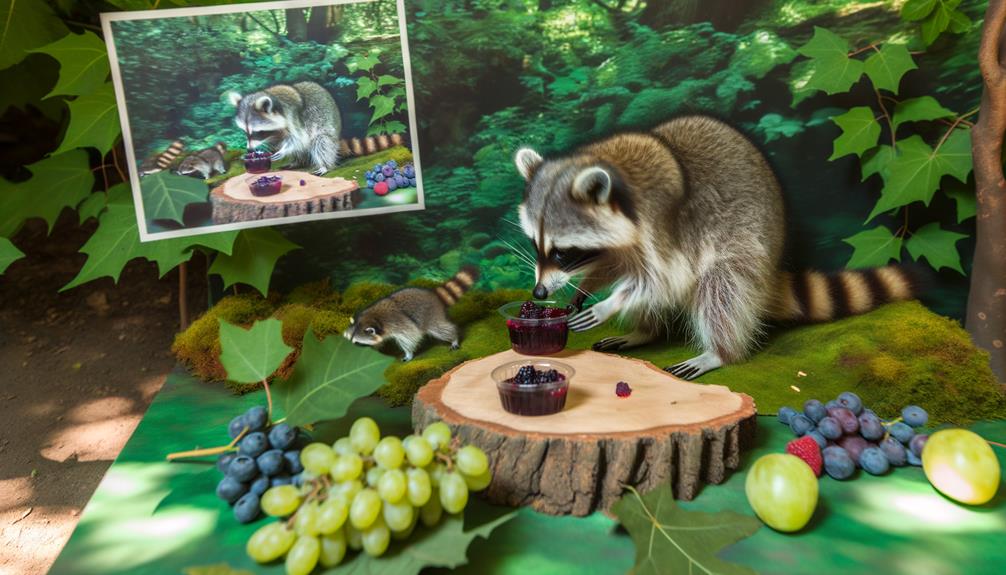
Raccoons are omnivorous animals whose natural diet encompasses a diverse array of foods including fruits, nuts, insects, small mammals, and aquatic organisms.
Scientific studies have shown that raccoons exhibit a highly adaptable foraging behavior, allowing them to exploit various food sources depending on seasonal availability.
Fruits such as berries and nuts are a significant part of their diet, often consumed during the summer and fall.
Insects and small mammals provide essential proteins, while aquatic organisms like crayfish and amphibians are frequently sought in wetland habitats.
This dietary flexibility not only ensures their nutritional needs are met but also enhances their survival in diverse ecosystems.
Understanding these dietary preferences offers insights into raccoon behavior and ecological interactions.
Urban Adaptation
Frequently, urban environments present raccoons with unique foraging opportunities that noticeably differ from their natural habitats. Urban raccoons exploit human-generated food sources, including refuse, pet food, and bird feeders, which can significantly enhance their diet.
Studies indicate that raccoons exhibit remarkable adaptability, often altering their activity patterns and foraging behaviors to maximize access to these resources. This adaptability is demonstrated through their nocturnal scavenging and dexterous manipulation of various urban objects.
Research underscores that urban raccoons tend to have higher body weights and reproductive success compared to their rural counterparts, likely due to the consistent availability of high-calorie food sources. Such behavioral plasticity highlights the raccoon's capacity to thrive in anthropogenic landscapes, raising important considerations for urban wildlife management.
Sweet Tooth Evidence
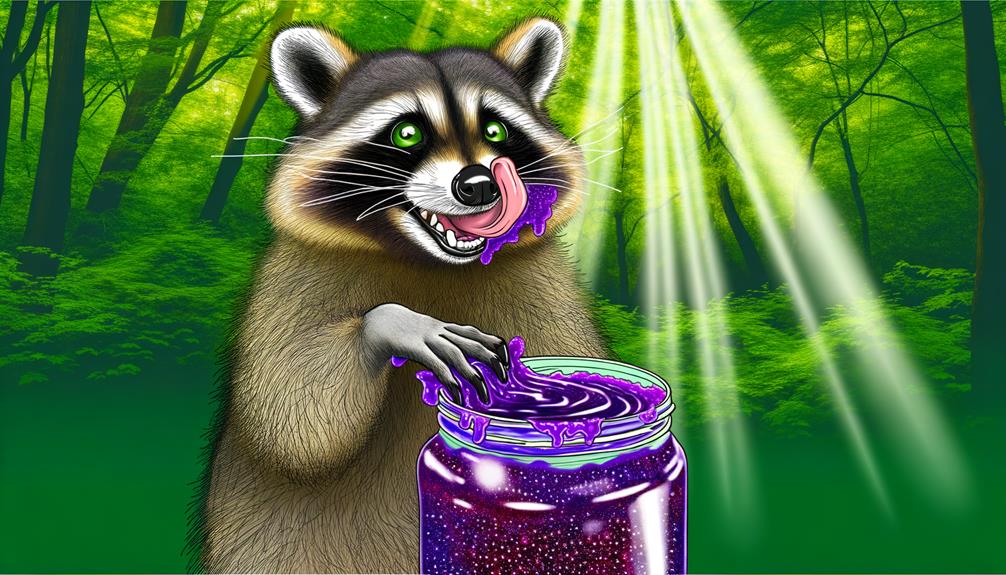
Evidence of raccoons' affinity for sweet foods, including grape jelly, is supported by observational field studies documenting their feeding behavior in urban and suburban environments.
Dietary preferences analysis reveals a significant inclination towards high-sugar foods when available, suggesting an adaptive strategy to exploit easily accessible energy sources.
Comparative sugar intake assessments further validate that raccoons consume substantial quantities of sugary substances, reinforcing the hypothesis of their sweet tooth.
Observational Field Studies
In various observational field studies, researchers have documented instances of raccoons consuming grape jelly, suggesting a preference for sugary foods. These studies often involve setting up controlled environments where raccoons are exposed to different food options, including grape jelly.
Field cameras and direct observation are frequently used to record raccoon behavior and food choices. Data analysis from these studies indicates that raccoons are not only attracted to grape jelly but will actively seek it out when available.
Such findings underscore the raccoon's opportunistic feeding habits and their tendency towards high-sugar content foods. These observations are essential for understanding raccoon dietary behaviors and can inform both wildlife management strategies and further scientific research into their feeding ecology.
Dietary Preferences Analysis
Data from various studies reveal a pronounced preference for sugary foods among raccoons, providing compelling evidence of their so-called 'sweet tooth.' This inclination is supported by multiple observational and controlled research efforts.
Key findings include:
- Field observations: Raccoons frequently raid bird feeders containing sugary substances, such as grape jelly and nectar.
- Experimental setups: Controlled experiments show raccoons consistently choosing sugar-laden options over protein-rich alternatives.
- Dietary analysis: Examination of raccoon scat often reveals high sugar content from fruits and human food waste.
- Behavioral patterns: Raccoons exhibit a tendency to return repeatedly to sources of sweet food, indicating a strong preference.
These findings underscore the raccoon's dietary inclination towards sweet foods, which aligns well with anecdotal evidence from wildlife enthusiasts.
Comparative Sugar Intake
A comparative analysis of sugar intake among raccoons and other omnivores reveals that raccoons exhibit one of the highest preferences for sugary foods, reinforcing the notion of their pronounced 'sweet tooth.'
Studies indicate that raccoons often choose sweetened foods over other dietary options when presented with a variety of choices. This preference is comparable to, if not exceeding, that of other known sugar-lovers like bears and certain species of primates.
The high sugar content in foods such as grape jelly appeals to raccoons' natural inclination for energy-dense sustenance, which is vital for their survival strategy. This evidence underscores raccoons' adaptive foraging behavior, highlighting their ability to exploit human-provided food sources effectively.
Pantry Raids
Raccoons are known for their opportunistic foraging behavior, often leading them to raid household pantries in search of easily accessible food sources, including grape jelly. These nocturnal animals frequently target common household items such as bread, fruit, and sugary substances.
Implementing preventive measures like securing trash cans and sealing food containers can mitigate the risk of unwanted visits.
Raccoons' Opportunistic Foraging
In their opportunistic foraging behavior, raccoons frequently raid pantries and garbage bins, exploiting a wide variety of available food sources, including grape jelly. These nocturnal mammals are highly adaptable, often thriving in urban environments due to their flexible diet.
Studies have shown that raccoons can consume:
- Fruits and Vegetables: such as berries, apples, and corn.
- Protein-rich Sources: including insects, small mammals, and bird eggs.
- Human Food Waste: particularly leftovers and discarded food items.
- Processed Foods: such as bread, peanut butter, and grape jelly.
This adaptability is a key factor in their survival and proliferation in varied habitats. By understanding their foraging patterns, better management strategies can be developed to mitigate human-wildlife conflicts.
Common Household Targets
Capitalizing on their keen sense of smell and dexterous paws, raccoons often infiltrate household pantries to access a variety of food items, ranging from cereals and snacks to sweet treats like grape jelly. Studies indicate that raccoons are adept at opening containers, utilizing their nimble paws to manipulate lids and packaging.
Their remarkable olfactory capabilities enable them to detect food even in sealed containers. Common targets include bread, grains, and sugary substances, which provide high caloric content essential for their foraging needs. These pantry raids are typically nocturnal, aligning with raccoons' nocturnal nature.
Observational data suggest that once raccoons identify a reliable food source, they are likely to return, making repeated incursions into household pantries.
Preventing Unwanted Visits
Implementing effective strategies to secure household pantries can greatly reduce the likelihood of raccoon intrusions.
Research indicates that raccoons are highly adept at exploiting any weaknesses in home security. To mitigate this issue, consider the following measures:
- Install Secure Locks: Use raccoon-proof locks on pantry doors or cabinets to prevent access.
- Seal Entry Points: Identify and seal any gaps or openings in the home structure that raccoons could use to enter.
- Store Food Properly: Utilize airtight containers for storing food items, minimizing scent trails that attract raccoons.
- Regular Inspections: Conduct periodic inspections of your home's exterior and interior for potential vulnerabilities.
Health Implications
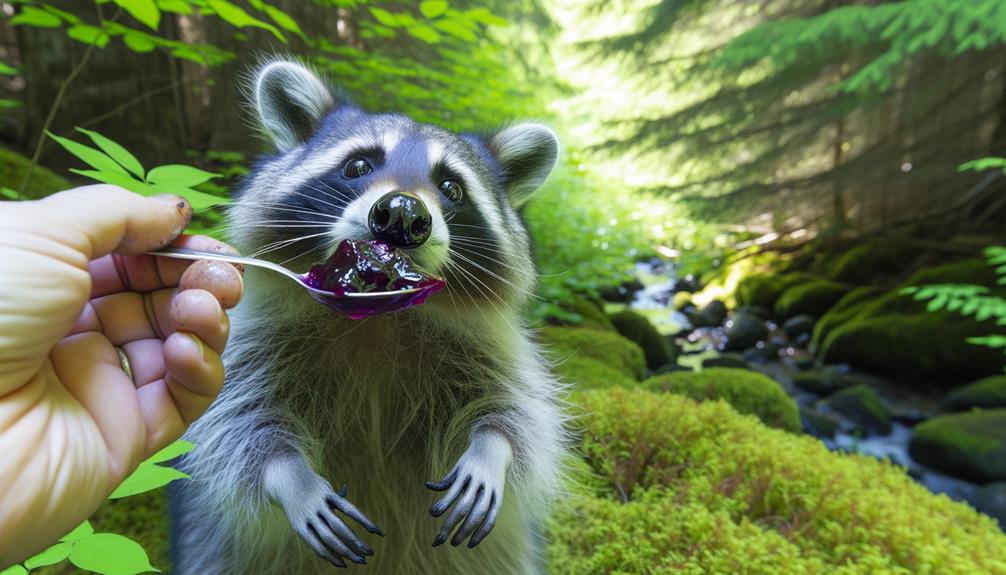
Consuming grape jelly can have several health implications for raccoons, primarily due to its high sugar content and lack of essential nutrients. The excessive sugar intake can lead to obesity, diabetes, and dental problems in raccoons, similar to issues observed in humans and other mammals.
Grape jelly also lacks crucial proteins, fats, vitamins, and minerals that raccoons need for a balanced diet, potentially leading to malnutrition and weakened immune systems. Additionally, the artificial additives and preservatives commonly found in commercial grape jelly could pose further health risks, including allergic reactions or gastrointestinal distress.
While raccoons may find grape jelly palatable, it is not an appropriate or healthy food source for them.
Preventing Raccoon Visits
Given the health risks associated with raccoons consuming grape jelly, it becomes important to explore effective strategies for preventing these animals from frequenting areas where such food is accessible.
Implementing thorough measures can notably reduce raccoon visits.
- Secure Trash Bins: Utilize raccoon-proof garbage bins with tight-fitting lids to minimize food availability.
- Remove Outdoor Food Sources: Eliminate bird feeders or secure them in a way that raccoons cannot access.
- Install Fencing: Erect barriers around gardens and potential food sources to deter raccoons.
- Use Deterrents: Implement motion-activated lights or sprinkler systems to scare off raccoons.
These strategies are grounded in evidence suggesting that reducing food accessibility and employing deterrents are effective in mitigating raccoon presence.
Conclusion
Raccoons exhibit dietary flexibility, consuming a wide range of foods from their natural diet to urban offerings. Evidence indicates a particular affinity for sweet substances, including grape jelly. Such pantry raids underscore their adaptability but raise health concerns due to high sugar intake.
Preventative measures can mitigate raccoon visits, reducing potential health risks and property damage. Overall, understanding raccoon dietary behaviors is essential for effective wildlife management and urban coexistence strategies.

